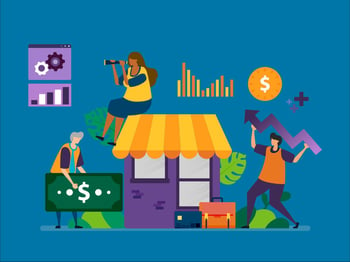Today, we announced that we’ve officially acquired ClickSWITCH—a company with incredibly talented and passionate professionals who build digital account switching solutions for banks, credit unions, and fintechs. By easing the account switching experience for account holders, ClickSWITCH helps financial providers acquire and retain more profitable consumer banking relationships.
But what is “digital account switching,” exactly, and why does it matter to financial services providers?
Completing the Digital Account Opening Circle
The pressure for financial providers to digitize the account opening experience has been mounting for years. Mega banks have poured billions into digital customer acquisition, while fintechs and challenger banks have simplified the enrollment experience to just a few mobile or web-based steps. The events of 2020 only underscored the need for FIs and every other financial services provider to make it easy to open accounts digitally: at the height of the Covid-19 crisis in Q2 2020, nearly two-thirds of new checking account applications were submitted online or via mobile device.*
That figure alone demonstrates how much progress FIs have made in getting up to speed with digital account opening capabilities. But where even the best digital account opening experiences fall short is in driving the behavior that really matters with a new account holder: becoming the primary account where they receive—and spend—their paychecks.
This step, arguably the single most important in establishing long-lasting, profitable consumer banking relationships, is largely unaccounted for in today’s digital account opening solutions.
Why Primary Account Status Matters
Monetizing consumer relationships has become an increasingly challenging proposition; tightening consumer protection regulation and mounting servicing costs make it hard for financial providers to work the math in their favor. The remaining opportunities for providers to derive value from consumer relationships are interchange revenue from debit card transactions, using consumer deposits to fund interest-bearing loans, and the more indirect benefit of cross-selling products and services down the line after establishing a meaningful initial relationship with an account holder.
Each of these benefits, however, depends on meaningful spending and saving activity on the part of the account holder, and the key to that activity is to become the place where an account holder has their money. Put simply, in today’s environment, becoming the account where an account holder receives their paycheck, via direct deposit, is the primary path to profitable consumer relationships.
And in spite of the rapid growth of many fintechs and challenger banks, they face the same issue at perhaps an even more critical level: while they’ve made it easy to enroll in their services, leading to unparalleled user growth, they often don’t have the breadth of products that financial institutions use to operate a profitable business. In other words, Challenger A may be adding 100,000 users a month—but the majority of those users aren’t generating income for Challenger A, and therefore represent cost to Challenger A. That is, unless Challenger A can solve the direct deposit dilemma.
Because most challengers are venture-backed, finding a way to consistently monetize new users isn’t just one consideration in a larger strategy—it’s an urgent imperative for their survival.
Putting the Ball in FIs’ Court: Solving the Direct Deposit Dilemma
Whether you’re a traditional FI or a fintech challenger, the imperative to secure a new account holder’s direct deposit is clear. Making it happen consistently is an altogether more difficult challenge.
Direct deposit is most commonly handled directly between a new account holder and their employer—so while it’s a critical juncture in the new account opening experience, it’s also traditionally been outside of financial providers’ ability to influence. On top of that, each employer handles direct deposit a little bit differently, meaning there’s no one-size-fits-all approach to updating direct deposit info across employers. The cost for a single financial provider to manage this on their own would be exorbitant.
This is where ClickSWITCH comes in. By building direct integrations with thousands of employers, they offer a streamlined, automated experience for updating direct deposit and recurring payment information right at the time an account holder opens a new account. Instead of an account holder completing the account opening process with a new financial provider, then navigating a completely separate direct deposit process with their employer, ClickSWITCH allows account holders to complete both sides of the process in one fell (and simple) swoop. And the best part is, the financial provider doesn’t have to deal with the complexity of managing thousands of potential employers and their direct deposit rules.
By putting clients in a position to solve a friction point for new account holders, ClickSWITCH helps them take a more active posture in driving the all-important direct deposit behavior more consistently. And the results speak for themselves: many ClickSWITCH clients have quickly generated more than $150M in deposits simply by adding the tool to their digital offerings.
For financial institutions and fintechs looking to close the loop on digital acquisition and onboarding and drive the saving and spending behavior that leads to value, ClickSWITCH is ready to help.
To learn more about ClickSWITCH, attend our webinar with founder Cale Johnston on April 8th.
Source for statistic in paragraph #3: https://www.forbes.com/sites/ronshevlin/2020/09/21/new-consumer-research-finds-consumers-open-more-checking-accounts-digitally-than-in-branches/?sh=4f337d0422af





